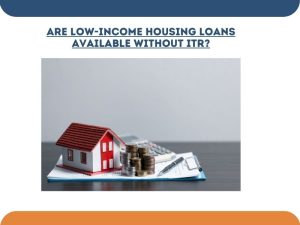December 8, 2024
Affordable Housing Loans for Low-Income Families – Apply Now

How to Apply for Low-Income Housing Loans in India
Owning a home is a dream for many, but for low-income families in India, it often feels out of reach. However, low-income housing loans make this dream attainable. These loans, offered by banks, financial institutions, and government-backed schemes, are tailored to help individuals from economically weaker sections (EWS) and lower-income groups (LIG). Here’s a detailed guide on how to apply for low-income housing loans in India.
What Are Low-Income Housing Loans?
Low-income housing loans are specifically designed financial products aimed at assisting individuals with limited financial means. They make homeownership accessible by offering:
- Lower interest rates: Affordable monthly EMIs ensure minimal financial strain.
- Flexible repayment terms: Loan tenures are customized to suit the borrower’s repayment capacity.
- Minimal eligibility requirements: Lenders often prioritize affordability over stringent credit checks.
Discover More : Affordable Housing Challenges in 2025

Eligibility Criteria for Low-Income Housing Loans
Before applying for a low-income housing loan, it’s essential to ensure that you meet the eligibility requirements. While criteria may vary between lenders, here are some common factors:
Income Requirements
- Your annual household income should align with the limits set for EWS or LIG categories.
- EWS typically includes households with an income of up to ₹3,00,000 annually, while LIG may cover those earning between ₹3,00,001 and ₹6,00,000.
Age Limit
- Most lenders require borrowers to be at least 18 years old and not older than 65 at the time of loan maturity.
Employment Status
- A stable source of income is crucial. Whether you are salaried or self-employed, you must prove your ability to repay the loan.
Credit Score
- A decent credit score improves your loan eligibility. However, many lenders consider first-time borrowers under such schemes.
Property Requirements
- The property you wish to purchase must meet legal and technical compliance standards set by the lender.
How to Apply for Low-Income Housing Loans
Applying for a low-income housing loan is a simple yet structured process. Follow these steps to streamline your application:
Step 1: Research Suitable Lenders
Start by identifying banks and financial institutions offering low-income housing loans. Compare their interest rates, processing fees, and repayment terms. Many lenders also have exclusive partnerships with government housing schemes, making them a viable choice.
Step 2: Check Your Eligibility
Once you’ve shortlisted lenders, assess their specific eligibility criteria. Use online tools like loan eligibility calculators to understand how much you can borrow.
Step 3: Gather Required Documents
Having the necessary documents ready can significantly speed up the process. Commonly required documents include:
- Identity proof: Aadhar Card, PAN Card, or Passport.
- Address proof: Utility bills, rental agreements, or voter ID.
- Income proof: Salary slips, bank statements, or income tax returns.
- Property documents: Sale agreement, property title, or ownership papers.
- Photographs: Recent passport-sized photos of all applicants.
Step 4: Fill Out the Loan Application
- Visit the lender’s branch or apply online through their website.
- Accurately fill in details such as personal information, employment status, and property details.
- Attach all supporting documents before submitting the form.
Step 5: Verification and Processing
Once the application is submitted, the lender initiates the verification process. This involves:
- Document scrutiny: The lender validates your identity, income, and property papers.
- Credit assessment: Your creditworthiness is evaluated based on your credit history and repayment capability.
Step 6: Approval and Disbursement
If your application meets the lender’s criteria, the loan gets approved. You’ll receive a formal sanction letter specifying the loan amount, tenure, and interest rate. After signing the agreement, the loan amount is disbursed to your account or directly to the seller/developer.
Explore More : Subsidized Housing Loans for Women

Government Schemes Supporting Low-Income Housing Loans
Several government schemes in India aim to promote affordable housing. Here are the most prominent ones:
Pradhan Mantri Awas Yojana (PMAY)
- Launched in 2015, PMAY is a flagship housing scheme that offers interest subsidies through the Credit Linked Subsidy Scheme (CLSS).
- Beneficiaries from EWS and LIG categories can avail of subsidies on home loan interest rates, making EMIs significantly affordable.
Housing for All Initiative
- This initiative focuses on providing housing to all citizens by 2024.
- It encourages developers to build affordable housing units and provides financial support to low-income families.
State-Level Schemes
- Many states have their own affordable housing schemes that complement PMAY.
- These schemes often provide additional financial assistance or subsidies.
Benefits of Low-Income Housing Loans
Low-income housing loans come with several advantages that make them a preferred choice for first-time homebuyers:
- Affordable EMIs: Lower interest rates and subsidies reduce the monthly repayment burden.
- Flexible Repayment Tenures: Borrowers can choose longer tenures to make EMIs manageable.
- Minimal Documentation: The streamlined application process ensures faster approvals.
- Government Support: Subsidies and schemes like PMAY make housing loans even more accessible.
Tips for a Successful Application
- Improve Your Credit Score: A credit score above 650 can enhance your loan approval chances.
- Maintain Transparency: Accurately declare your income and financial commitments.
- Choose the Right Lender: Research and compare lenders for the best terms.
- Opt for Government Schemes: Apply under PMAY or state-specific schemes for additional benefits.
- Ensure Property Compliance: Verify that the property meets all legal and technical requirements.
Conclusion
Low-income housing loans have opened the door to homeownership for millions of families in India. By understanding the process and taking advantage of government schemes, you can secure a loan that fits your needs. Proper research, documentation, and financial planning are key to making your dream home a reality.
Vridhi Home Finance provides a variety of home loans tailored to suit your housing needs. Let us guide you in taking the first step towards your dream home. Apply today!



